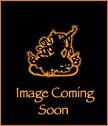
Item: Chakrasamvara (Buddhist Deity) - Sahaja Heruka
| Origin Location | Tibet |
|---|---|
| Date Range | 1800 - 1899 |
| Lineages | Karma (Kagyu) and Buddhist |
| Material | Ground Mineral Pigment on Cotton |
| Collection | Private |
Classification: Deity
Appearance: Semi-Peaceful
Gender: Male
Chakrasamvara Sahaja Heruka (Tibetan: khor lo dem chog, English: Wheel of Supreme Bliss): the foremost meditational deity of the Wisdom-mother classification of Anuttarayoga Tantra of Tantric Buddhism.
Tibetan: Khor lo dem chog
"Chakrasamvara, blue in colour, the right foot is extended pressing on red Kalaratri and the left drawn in [pressing] on black Bhairava. With one face and two hands, three eyes, the right hand holds a vajra and the left a bell; embracing the consort, with a crown of five dry human heads as a crown, a necklace of fifty wet, and adorned with the six bone ornaments. [Chakrasamvara is] embraced by the consort Vajravarahi, red in colour, with one face and two hands. The right hand holds a curved knife pointed to the ten directions. The left holds a skullcup filled with the five nectars and embraces the Father. [She is] adorned with a crown of five dry human heads, a [necklace] of fifty dry [heads] and the five bone ornaments." (Jamyang Kyentse Wangpo, 1820-1892).
At the top center is the Marpa Kagyu lineage of teachers. The group at the top left represents the Buddhas. The group at the top right represents the bodhisattvas. The group at the middle left represents Padmasambhava and the Nyingma Tradition deities. The group at the middle right represents Padampa Sanggye and Machig Labdron along with power deities.
The entire lower composition is comprised of protector deities of the two classes Wisdom and Worldly. The principal of the protectors is Bernagchen Mahakala.
The meditational deity Chakrasamvara is common to all the New Schools of Himalayan and Tibetan Buddhism (Sarma: Sakya, Kagyu and Gelug). Within the Gelug School the deity is commonly referred to as Heruka. Among the many different forms and mandalas of practice, this form with one face and two hands entered Tibet with the great translator Rinchen Zangpo in the 11th century.
Jeff Watt [updated 3-2016]
Collection of Dhargye Museum
Buddhist Deity: Chakrasamvara, Heruka
Collection of Dhargye Museum (Painting Gallery 2)
